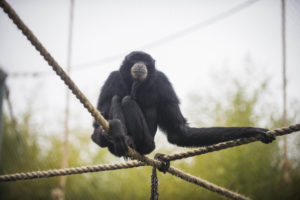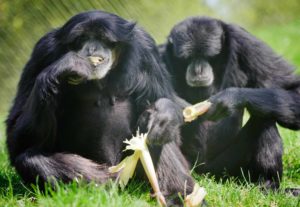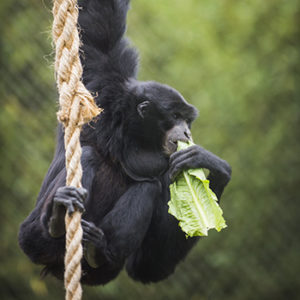How does it feel to be the oldest siamang?

Well, for Cho Cho, snuggled up with his companion Dudlee on a crisp fall morning at Point Defiance Zoo & Aquarium, it seemed pretty cozy.
This year Cho Cho is celebrating his 53rd birthday – which makes him the oldest siamang on record in human care in the U.S., and possibly the world. But thanks to the exceptional care he gets from our keepers and veterinary team, Cho Cho’s age isn’t slowing him down much.
“He’s in good shape,” said Asian Forest Sanctuary Curator Telena Welsh, gazing at Cho Cho all cuddled up with Dudlee in the heated hammock, with adoring visitors looking on.
“He is definitely set in his habits – he likes things to go his way,” adds Welsh. “But he’s still incredibly strong and clever. He often outsmarts keepers with enrichments, and is always observing everything around him.”

How to tell them apart visually? Dudlee has more gray around her muzzle, while Cho Cho has a floppy throat sac and is a bit skinnier.
Siamangs are the largest species of gibbon in the primate family. They’re found in the wild living in the treetops of tropical rainforests in Sumatra and on the Malay Peninsula – which is why Cho Cho and Dudlee love the ropes, hammocks and perches in the Zoo’s Asian Forest Sanctuary habitats they rotate around with other animals. While Dudlee (who’s 24) loves to spin on the ropes, Cho Cho chills out more, Welsh says.
“He’s showing his age a little more, moving more deliberately around his habitat,” she says.
But as well as seeing our siamangs, you can also hear them loud and clear, especially in the morning. Anyone who’s visited Point Defiance Park around 8am will have heard the unmistakable hoots and calls of our siamangs.
“Each species has its own song, and each individual has their separate part,” explains Welsh. “In the wild they would probably use it to mark out territory and define family units.”
Here at the Zoo they’re also known to react vocally to nearby noises such as festivals or ambulances.
So how do you care for the country’s oldest known siamang?

“We watch him closely,” says Welsh. “He does get vitamins, and occasionally an anti-inflammatory that works like ibuprofen to relieve any age-related stiffness.”
Like Dudlee, Cho Cho also has almost no teeth left – a normal thing for siamangs this age – so Welsh and her staff either cook their food or slice it very thinly. And of course he gets regular senior wellness checkups from our veterinary team.
Mostly, though, Cho Cho is a healthy fellow who likes to groom his mate, sunbathe, and interact with the humans who care for him.
As Welsh calls him, the old siamang climbs over to the fence and puts a hand through, gently touching Welsh’s own in greeting – then lopes away after Dudlee.